-
Paper Information
- Next Paper
- Paper Submission
-
Journal Information
- About This Journal
- Editorial Board
- Current Issue
- Archive
- Author Guidelines
- Contact Us
International Journal of Food Science and Nutrition Engineering
p-ISSN: 2166-5168 e-ISSN: 2166-5192
2012; 2(3): 21-26
doi:10.5923/j.food.20120203.02
Production and Effect of Storage in The Chemical Composition of Mozzarella Cheese
Abdel Moneim E.Sulieman, Rasha A. Mohamed Ali, Kamal A. Abdel Razig
Department of Food Science and Technology-Faculty of Engineering and Technology-University of Gezira, Wad Medani, Sudan
Correspondence to: Abdel Moneim E.Sulieman, Department of Food Science and Technology-Faculty of Engineering and Technology-University of Gezira, Wad Medani, Sudan.
| Email: |  |
Copyright © 2012 Scientific & Academic Publishing. All Rights Reserved.
The present study aimed at the determining the storage stability of the yield and the physico-chemical characteristics of mozzarella cheese prepared from cow milk, goat milk and a mixture of cow and goat milk. The cheeses were subjected to the analyses during different storage periods (first day , 15th day and 30th day after manufacturing). Mozarella cheese contained appreciable amounts of minerlas, calcium, sodium, phosphorus and potassium throughout the storage period. The pH ranged (4.93 – 5.21, 4.83 – 5.13 and 4.82 – 5.23), while the contents of protein ranged (17.73 – 26.13, 18.86 – 26.53 and 17.82 – 26.93) % and the fat content ranged (15.07 – 24.87, 16.53 – 21.17 and 14.03 – 24.12)% at first day, 15th day and 30th day of storage period, respectively. Most of the most of chemical components of mozarella cheese were not affected by storage. These components were significantly affected by milk types. The results also indicated that mixture milk mozzarella cheese (MMMC) had higher cheese yield which differe significantly (p≤0.05) from other cheese types throughout storage period. The study recommended encouraging dairy industry in Sudan to use goat's milk or a mixture of goat's and cow's milk in production of mozarella cheese.
Keywords: Cow Milk, Goat Milk, Chemical Analysis, Minerals
Cite this paper: Abdel Moneim E.Sulieman, Rasha A. Mohamed Ali, Kamal A. Abdel Razig, Production and Effect of Storage in The Chemical Composition of Mozzarella Cheese, International Journal of Food Science and Nutrition Engineering, Vol. 2 No. 3, 2012, pp. 21-26. doi: 10.5923/j.food.20120203.02.
Article Outline
1. Introduction
- Cheese can be good addition to your food. Cheese is a nutrient-dense food made from cows, buffalo, goats, or sheep, by coagulation. Some cheeses also have molds, either on the outer rind (similar to a fruit peel) or throughout. The precise nutritional composition of cheese is determined by multi factorial parameters, including the type of milk used (species, breed, stage of lactation, and fat content) and the manufacturing and ripening procedures[1]. In general, cheese is rich in the fat and casein constituents of milk, which are retained in the curd during manufacture, and it contains relatively small amounts of the water soluble constituents (whey proteins lactose, and water-soluble vitamins), which partition mainly into the whey. Like most dairy products, cheese is a rich source of minerals, protein, vitamin, fat and carbohydrate.There are hundreds of different types of cheese available across the globe and the sad part is not one type of categorization can encompass all these cheese types. Cheese can be classified on the basis of their country of origin, fat content (milk type), and texture, manufacturing technique, physical appearance like shape or moisture content. In this article we will have a look at some commonly used cheese varieties and learn more about them[2].Mozarella cheese is a mild, white fresh cheese made by a special process where the curd is dipped into hot whey then stretched and kneaded to the desired consistency. At one point, mozzarella was made only from water buffalo milk. Now, it is usually made with cow's milk. There are two forms, regular and fresh. Regular mozzarella is available in low-fat and nonfat forms and has a semi-soft, elastic texture and is drier than fresh mozzarella. Fresh mozzarella is made from whole milk and has a softer texture and sweet, delicate flavor and is typically packed in water or whey. Mozzarella cheese has many health benefits; it is a good source of protein, vitamins and minerals. Consumption of mozzarella cheese may protect against gout, a painful condition that results in the buildup of uric acid crystals in the joints. The calcium found in mozzarella cheese also has its contribution in body weight loss and provides protection against breast cancer and metabolic syndrome, which is a group of conditions that increase the risk of developing heart disease or stroke[3].Mozarella cheese has been introduced to Sudanese markets very recently, and research concerning it in Sudan is very limited. Therefore the present study was initiated to study the chemical composition and yield of Mozzarella cheese prepared at laboratory level from cow’s milk, goat’s milk and mixed milk (1:1 cow’s milk: goat’s milk) throughout storage period.
2. Materials and Methods
- Fresh cow’s and goat’s milk were obtained from Khartoum North (Hilat Koko). They were collected in sterilized screw capped bottles immediately after milking, and kept at low temperature by using refrigerator to suppress microbial growth. Powder of calf’s rennet (Hansen Sticks, France) was obtained from local market and fresh Capo yoghurt was used as starter culture obtained from local market.
2.1. Preparation of Mozzarella Cheese at Laboratory Level
- Mozzarella cheese was produced using cow’s milk, goat’s milk and mixture milk (1:1 cow’s milk: goat’s milk).The milk (124.5) liters were filtrated and heated to 38°C by heater, then (160) g of starter culture (Capo Yoghurt) and (1) g of calf’s rennet were added to the mixture. The mixture was blended for 10 minutes and was let for 30-60 minutes until the curd separated from the whey. The curd was collected, broken and laid on a table to drain and to age for about 20 minutes. Hot water at 90° was added to the curd in a bowl, the curd was mixed and kneaded by hand until homogeneous paste obtained. The curd was immersed in cold Na Cl solution (12%) at 6° for 6 hours, and then let to dry for 4 hours. Finally, the curd (mozzarella cheese) was packed in sterilized plastic bags and kept for 1 month at (4°) for further study.
2.2. Chemical Analysis
- The proximate chemical analysis of laboratory-made mozzarella cheeses were carried out to determine the contents moisture, ash, fat and protein according to AOAC[4] methods. The yield % of the cheese was calculated as well. For determination of titrable acidity, the titermetric method was used according to the AOAC[4]. The sample taken for determination of cheese acidity was 5 g dispersed in 100 ml of distilled water in 250 ml conical flask, and then six drops of phenolphthalein indicator were added. The sample was then titrated with 0.1N sodium hydroxide until a stable pink color was formed. The titrable acidity was expressed as % lactic acid from the following formula.
 Where T: is the amount of lactic acid reacted with 1.0 ml of 0.1N sodium hydroxide.The pH of mozzarella cheese samples were determined using digital pH meter (PN9410). The pH meter was calibrated with buffers of pH 4 and 7. The cheese samples were stirrer and the pH value was recorded according to AOAC[4].The total solid content of the different cheese samples was determined according to AOAC[4]. Three grams of samples were weighed into a dry clean crucible, and then heated in water bath for 10- 15 minutes. The dish was then placed in an oven at 80℃ overnight (16 hours) cooled down in desiccators and weighed. The total solid content was calculated from the following equation:
Where T: is the amount of lactic acid reacted with 1.0 ml of 0.1N sodium hydroxide.The pH of mozzarella cheese samples were determined using digital pH meter (PN9410). The pH meter was calibrated with buffers of pH 4 and 7. The cheese samples were stirrer and the pH value was recorded according to AOAC[4].The total solid content of the different cheese samples was determined according to AOAC[4]. Three grams of samples were weighed into a dry clean crucible, and then heated in water bath for 10- 15 minutes. The dish was then placed in an oven at 80℃ overnight (16 hours) cooled down in desiccators and weighed. The total solid content was calculated from the following equation: Where:W1 = weight of sample after dryingW2 = original of sample
Where:W1 = weight of sample after dryingW2 = original of sample2.3. Determination of Minerals
- Mineral (Ca, K, Na and P) contents of processed cheese samples were determined according to Pearson (1981) using spectrophotometer.
2.4. Determination of Salt
- The salt content of mozzarella cheese samples was determined according to AOAC,[4]. In which 5 gm samples were weighed and placed into 250 ml conical flask, also 100 ml boiling water were added. Then, swirled for 10 min and cooled to 50 - 55°. Titrated against silver nitrate till the color of indicator potassium chromate changed from pale yellow to buffered color and titration figure was recorded (V).Calculation of salt % w/w as follows:
 N = Normality of silver nitrate.W = weight of sample. V = weight of silver nitrate.
N = Normality of silver nitrate.W = weight of sample. V = weight of silver nitrate.2.5. Cheese yield
- The obtained cheese was weighed immediately after ripened using a weighing balance (Mettler H33 AR type), the weights of cheese samples were recorded, and the yield of the cheese was calculated as follow:

2.6 Statistical Analysis
- Data obtained were assessed by analysis of variance (ANOVA) as shown by Sendecor and Cochran[5] and means were compared using Duncan’s multiple- range test[6] with probability p ≤ 0.05.
3. Results and Discussion
3.1. Chemical Composition of the Laboratory–Made Mozzarella Cheese
- Figure (1) shows the result of titrable acidity as lactic acid (mg/100g) during storage period for mozzarella cheese types prepared from cow’s, goat’s and mixture milk (1:1 cow’s milk: goat’s milk). The titrable acidity (expressed as lactic acid%) of cow’s milk mozzarella cheese (CMMC) was 0.203 ± 0.01%, this value was lower than that of El Owni and Osman[7], who reported a value of 0.59 ± 0.90% in CMMC. The titrable acidity of goat’s milk mozzarella cheese (GMMC) was 0.13 ± 0.01% which was lower than the value 1.51 ± 0.02% obtained by Srbinovska et. al.[8]. However, the titrable acidity of GMMC was significantly lower than that of CMMC and MMMC throughout the storage period; however no significant difference was found in titrable acidity of mixture milk mozzarella cheese at 30 day at storage period compared to other samples. Figure (1) also shows the pH values during storage period for the different mozzarella cheese types. The pH of CMMC was 5.2 ± 0.1, this value is similar to that of Sameen et. al.[9], who reported a value of 5.23 ±0.01 in cow's milk mozzarella cheese. The pH of GMMC (5.21 ± 0.001) was in close agreement to the value 5.6 ± 0.1 obtained by Srbinovska et. al.[8]. The pH of MMMC was significantly lower than that of CMMC and GMMC throughout the storage period. No significant difference was found in pH of GMMC compared to that of CMMC throughout storage period.
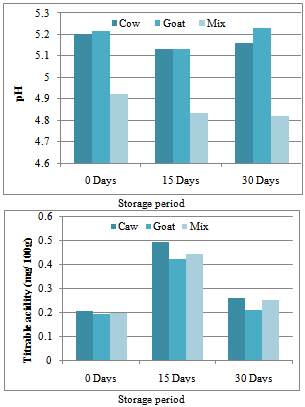 | Figure 1. The effect of storage on titrable acidity and pH of mozzarella cheeses |
 | Figure 2. The effect of storage on salt and total solids % of mozzarella cheese types |
 | Figure 3. The effect of storage on moisture and ash contents of mozzarella cheese |
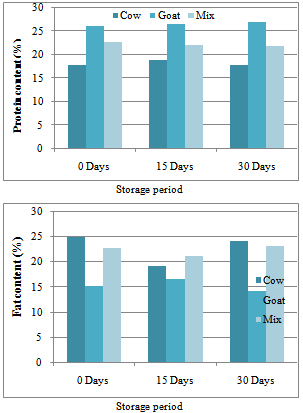 | Figure 4. The effect of storage on fat and protein contents of mozzarella cheese |
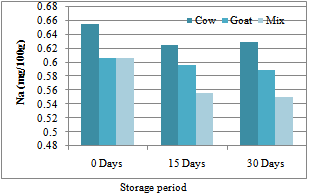 | Figure 5. The effect of storage on calcium content of mozzarella cheese |
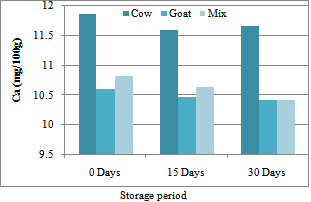 | Figure 6. The effect of storage on sodium of mozzarella cheese |
3.2. Minerals Contents of Mozzarella Cheese
- Figures (5-8) present the effect of storage in the contents of different minerals (mg/100g) during storage period for all mozzarella cheese types. The calcium content (Fig.5) of CMMC was significantly higher than that of GMMC and MMMC during the storage period. Sodium content (Fig.6) of MMMC was significantly higher than that of GMMC and lower than that of CMMC at the first day and 15th day of storage period, respectively. However, sodium content of CMMC was 11.67 ±0.01 significantly higher than that of GMMC and MMMC at the 30th day of storage period. Non-significant difference in potassium content (Fig. 7) was found between MMMC (1.333 ±0.01) and CMMC cheese (1.33 ±0.01), however, these values were significantly higher than that of GMMC at the first day of storage period. On the other hand, potassium content of CMMC was significantly higher than that of MMMC and GMMC at the 15th day and the 30th day of storage period. The phosphorus content (Fig. 8) of MMMC was significantly higher than that of GMMC, and significantly lower than that of CMMC at the first day, however, MMMC was significantly lower than that of GMMC and CMMC at the 15th and 30th day of storage period.
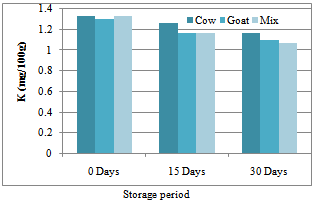 | Figure 7. The effect of storage on potassium content of mozzarella cheese |
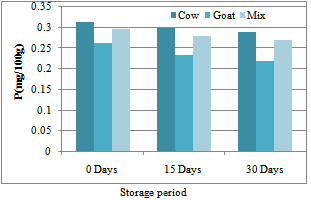 | Figure 8. The effect of storage on phosphorus content of mozzarella cheese |
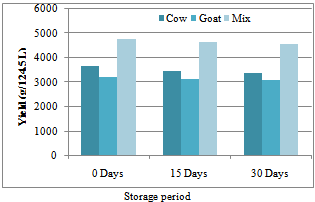 | Figure 9. The effect of storage on yield of mozzarella cheese |
3.3. Mozzarella Cheese Yield (g/124.5 lit)
- Figure (9) shows the results of mozzarella cheese yield% during storage period for all mozzarella cheese types. The yield of MMMC was significantly higher than that of GMMC and CMMC at the first day, 15th day and 30th day of storage period.
4. Conclusions
- Mozzarella cheese prepared from mixture milk (1:1 goat’s milk: cow’s milk) gave the highest yield and total solid throughout all storage periods. However, the moisture, titrable acidity and salt recorded the highest contents at the 30th day of storage period, while the fat content had the highest value at the 15th day of storage period. All mozzarella cheese samples contained appreciable amounts of minerals throughout storage periods. It is recommended encouraging dairy industries in Sudan to produce mozzarella cheese from both cow's and goat's milk and a mixture of both.
ACKNOWLEDGEMENTS
- This work forms part of a research performed at the Department of Food Science and Technology, Faculty of Engineering and Technology, Gezira University. The authors express their sincere thanks to all staff members, technicians and the colleagues of the Department for their support and assistance.
 Abstract
Abstract Reference
Reference Full-Text PDF
Full-Text PDF Full-text HTML
Full-text HTML